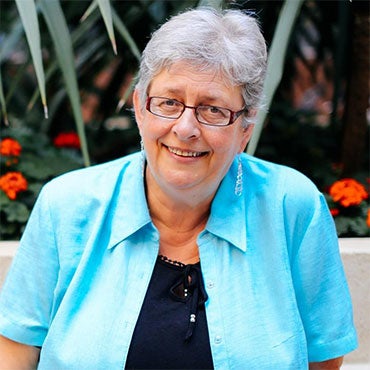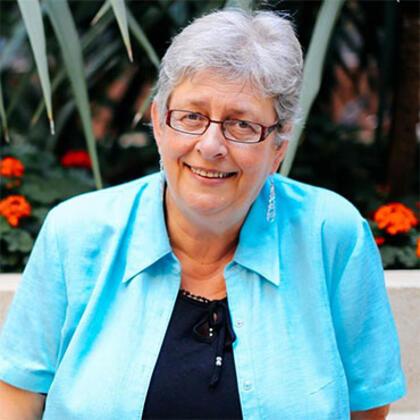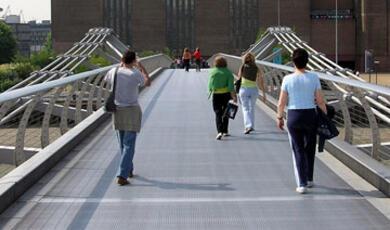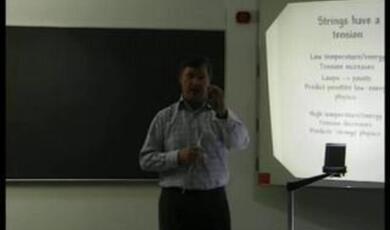Greenness and UK Environmental Challenges
Share
- Details
- Transcript
- Audio
- Downloads
- Extra Reading
The world faces environmental challenges from global to local levels. Well-rehearsed but impenetrable issues, include the increased likelihood of damage to life and infrastructure from climate change; carbon management policies for governments; increasing levels of poverty and hunger associated with growing populations; and, potentially, mass movement of environmental migrants.
Download Transcript
16 October 2014
Greenness and UK Environmental Challenges
Professor Carolyn Roberts
Firstly, I would like to offer my sincere thanks to the Frank Jackson Foundation, for sponsoring me as the first Professor of Environment at Gresham College, and in fact only the second new Chair in four hundred years. I am inordinately grateful for this opportunity, and I hope that Gresham’s engagement with this new cross-disciplinary realm – the intersection of science, social science, economics, politics and the arts, perhaps even the dark arts, will prove a rewarding one.
I am a scientist, an environmental scientist focusing on human influence on the water environment, and with a passion for attempting to manage this, one of our life-critical resources, better. I have had a lengthy academic career, most recently at Oxford University, running alongside an environmental consultancy dealing with a range of environmental challenges such as mining, housing development, industrial contamination, drinking water degradation, drought and flooding. I have researched in the UK, Europe, North and sub-Saharan Africa and other places. My current job at the Knowledge Transfer Network, is funded by the UK Government to bring researchers closer to businesses in order to stimulate the research and development of new environmental technologies – innovative ways of managing humanity’s needs for water, energy, food, resources and so on. So I do have a keen interest in innovation – the practical application of the science. Occasionally, as a service for the police, I also track the movement of dead bodies, usually murder victims, as they float through river and canal systems, something I will elaborate upon in a later talk. A TV series is yet to come, and I dare say will require a more attractive and agile female lead.
My forthcoming Gresham lectures will reflect on the challenges of applying environmental science, specifically water science, to solve real world problems and to promote sustainable practice. The talks will tease out some themes around innovation, specifically open innovation, and partnership, drawing in part on my own research and consultancy experiences. Applied science, innovation and partnership are all contested terms, and for those of you who have specific and detailed interest in one or other of these areas, I hope my analysis will not be too superficial. But over the course of this year and the next two, I will be looking specifically at the linkages brokered by the nature of the communications that occur between people working in different arenas, and from different perspectives – the science community, the politicians, industry, education, the voluntary sector and community groups, government agencies and so on. In fact, I will be allowing some of them to share their views with you, through recordings. I will be reflecting on whether technology, genetics, biochemistry, new physics, social media, the cloud, provide new opportunities for creating sustainable solutions to water problems, or raise more challenges than they solve. Are they beneficial, for example, in assisting innovation, desperately needed in a range of areas, or are they merely an illusion of agency?
Perhaps in no other realm of Gresham College’s interest would it be necessary to say that the lectures will not be relaying apocalyptic catalogues of catastrophe, hazard (environmental or moral) and conflict, but offering some thoughts on frameworks for considering environmental challenges, and perhaps the basis for optimism. In my view we are an innovative and resourceful species.
Firstly, however, I’d like to take a little diversion into the realms of ‘wickedness’. For those of you who, like me, are Gilbert and Sullivan aficionados, ‘The Wicked World’is a blank verseplay by W.S. Gilbert. It opened at the Haymarket Theatrein 1873 at the beginning of one of most famous collaborations in history, and was an allegory about conflict, reconciliation, moral hazard and the compensation that mortals are given for all the troubles they must endure on earth. Conflict, reconciliation, moral hazard and reward. Alongside other environmental resonances, the plot shares some similarities with Shakespeare’s Midsummer Night’s Dream, where humans and mythical beings, people with very different ambitions, collide. It also engages with the consequences that ensue when an all-female world is disrupted by men, something which about half of us in the audience may regard with wry amusement – a female-dominated world was laughable in Victorian times, and still is now too; women are amongst those most seriously compromised by environmentally-driven inequalities. ‘The Wicked World’ provoked a lot of dissent at the time, and in fact Gilbert sued The Pall Mall Gazette, which had called the play ‘indecent’ because of a reference to mortal love. Gilbert lost his case on indecency, incidentally; the play WAS ruled to be indecent.
Now, over the course of my lectures this year I want to explore a little more about Wicked Worlds, wickedness, or specifically the concept of ‘wicked problems’, and how ‘wicked environmental problems’ are conceptualised and addressed by different stakeholders, such as businesses, education, professional bodies, voluntary agencies and others.
I am going to start with a story.
About fifteen years ago, a colleague and I first took a group of UK undergraduates on a field trip to Uganda. The field trip also involved our participation in a development aid partnership with a teacher education college in a remote district in the east of the country. We were working with the National Teachers College Kaliro, at their request, to bring and install their first computers, and train their staff and students in their use. The computers were recycled from some of the high tech businesses in Cheltenham, and my students undertook a course in IT training, and worked together to raise the money to take the machines and the know how out to Africa. This was, I think, a worthy objective, which proved very successful and instigated a ten year mutually beneficial partnership. Friendships were initiated. Two or three undergraduates even went to Uganda afterwards to start businesses or development projects.
Whilst in Kaliro, I undertook a small piece of research with students from both institutions, looking at water use and water quality around Ugandan villages. Now Uganda is a very poor country, with a low Human Development Index of 0.456 in 2012. It lies at 161st out of 187 countries, a rank which despite its newly discovered oil resources, it shares with Haiti. Some other statistics (courtesy of Unicef) are shown on the slide, and it is a sobering picture.
There is no shortage of rainfall in Uganda, but there were and are enormous water-related health problems. The women and children in rural areas collect water from wells or boreholes, and the poorer ones from puddles or swamps, and carry it home in 25 litre plastic jerrycans; in the past these containers would have been more picturesque, but less effective. Most of them had and have limited money for fuel to boil the water, and for some people, especially children, the pathogens in the water produce chronic illnesses that kill them. The pattern of water use was the subject of earlier and seminal research by Gilbert White and colleagues in 1972, and by the time we went to Uganda some years later little had changed for the better, despite the efforts of a large number of aid agencies, scores of water policies, stakeholder engagement, and a commitment to the UN Millennium Development Goals. The Millennium Development Goals, by the way, were altered in the late 1990s to say that by 2015, next year, the number of people without safe access to drinking water and sanitation would be halved, surely not an unreasonable position in a world that had put people on the moon thirty years before and can now produce supercomputers that can do unbelievably complex weather simulations and allow us to play online games with people thousands of miles away, if we wish.
In fact whilst the number of people living in absolute poverty in Uganda has generally decreased since the 1990s, conversely as a result of population growth and the withdrawal of some centralised provision, the water situation was static or had worsened in many villages between 1972 and the 1990s. It is little better today. Women and children were walking away from traditional sources, and water was costing them a greater proportion of their income. Some sources had effectively been privatised. Moreover, when we analysed the groundwater in a range of villages, we discovered some serious water quality problems, illustrated on the slides. This is the environmental science. Each village had a zone of shallow contaminated water under it, represented here by a simple parameter, electrical conductivity, but reflecting the fact that provision of additional boreholes in accessible locations in villages had not been matched by provision of sanitation. Seepage of sewage from pit latrines, laundry water, industrial effluent and other waste material into and through the ground was contaminating the soil, and it was spreading. The contamination included inorganic chemical parameters such as nitrate and nitrite, phosphate and metallic ions, and bacteria including escherichia coli from human and animal wastes. The situation was known to the central government, who dispatched monitoring teams out from Kampala to collect and take reference samples back to the capital for analysis, but generally not known to the local people, many of whom were illiterate.
Now here we have an example of a ‘wicked’ problem, with a set of characteristics that make it very difficult to approach, and where solutions, in this case the provision of new boreholes by aid agencies trying to hit the Millennium Development Goals, have unintended consequences. The story goes something like this…..
Firstly, rapid population growth necessitates new sources, most of which in the interests of cost are boreholes or protected springs. Perhaps this is better than nothing. The Ugandan national policy, in line with the Millennium Development Goals, provides a basis for boreholes to be installed such that the population living within 1.5 km of a source is maximised (remember that 3 kilometre walk, with a jerrycan for each person in the household, and a baby). Boreholes are hence installed by all sorts of agencies (indeed we may have supported these ourselves) predominantly in populated areas where access is maximised but local groundwater is contaminated from pit latrines and other waste water. Despite this, there is a perception that water quality is good, and there is no perceived need to treat it. People hence abandon more traditional sources, to walk towards the nearest substantial settlement to collect the water. And it becomes increasingly contaminated over time, as our repeat sampling identified.
This is just one example of an insidious and wicked problem. Wicked problems have particular characteristics, as defined in 1973 by Americans Horst Rittel and Melvin Webber. Paraphrasing, wicked problems…
· Are poorly formulated and complex
· With interconnected physical/scientific and human/sociological dimensions…
· Where what happens in one place and time affects what happens somewhereelse, at a different time
· Involving many different stakeholders…
· Who don’t agree about what is important…
· And who use the terminology in different ways…
· And who cannot or could not agree if the problem has been solved
Environmental problems often have all the characteristics of ‘wicked problems’, typically defying traditional linear solutions and requiring more innovative ways of thinking, and partnerships, in order to solve them. Rittel and Webber noted that solutions are usually only ‘better’ or ‘worse’ rather than absolute, and that decisions must nevertheless be made in the light of scientific uncertainty. I want to ask you to hold in your mind, exactly what the problem is here, because that may underpin our approach to a solution. Is it that there is insufficient water? Or that someone is polluting the water? Or that the contamination is only in my (and my students’) mind(s) or is not known to the local people or the national government? Or that the appropriate technologies, including the communication systems, do not exist? Or that the local people are poor and cannot afford to construct effective infrastructure? And what about the appropriate solution – is it a clean borehole, or a piped supply in the house? Why should their expectations be less than ours?
I should add here that there has recently, in 2012, been a new paper describing ‘super wicked problems’, by Levin et al. These have additionally intractable characteristics such as the fact that they are urgent, those who cause the problem also seek to provide a solution, the central authority needed to address the problem is weak or non-existent, and that policy responses make decisions that disregard the future and reflect short time horizons. However, perhaps enough is enough. At the risk of perpetuating the misery, I nevertheless want to add to the story of Uganda’s villages. In many cases water yields at these boreholes are quite low, and although typical water demand is modest at about 20 litres per head, per day, there is queuing especially in the evenings. Trampling around the installation creates stagnant water pools, which attract mosquitoes, and before we know what is happening, malaria rates rise. Privatised health care flourishes, and because local inhabitants see this as an indication of progress, increased migration towards these settlements is promoted. This is a double, contingent cycle of wickedness, of course.
But there may be some solutions. Education for public participation is always a likely contender, and something to which we will return later on this evening. Technology and science also play a role. New types of portable equipment allow rapid characterisation of water quality, in areas that may lack mains electricity. There are new types of toilets where waste is captured rather than released, and treated anaerobically to generate energy and fertiliser. There are rapidly emerging communication technologies, invented by a UK team led by Drs Rob Hope and Gary Clifford at Oxford University, that are starting to address issues around borehole maintenance, using the massively expanding mobile phone network. More than half of the Ugandan population has a mobile phone now, up from 4% in 2004. These technological solutions would give cause for optimism, IF they are appropriate and are addressing the right problems. That agreement on what the problem is, is a very key issue, though. I will say more about this African example of an environmental challenge later in my lecture series.
Now, how does this the concept of wicked problems assist us in addressing environmental challenges? And indeed can we agree at least what the key environmental challenges are that we, the UK, and globally, face? Over the course of my lectures, I want to share with you the views of about eighty or so people professionally involved in environmental domains. Many are business people, perhaps not what you may have expected, but all are interested in innovation. As you will see, their views on what matters, and how to address the issues, differ hugely. Today, I have selected a just few examples of some of them reflecting on the environmental challenges that they think are most important. Let’s listen….
Key things coming out of this are that people do not share a common view on what is important – many relate importance to their own spheres of activity, naturally. They cite biodiversity, population pressures, water, energy security, food, resources, urban space, housing. The slide summarises their emphasis. We heard from the majority for whom climate change is a given, and those who remain somewhat sceptical (but not many of those, I hasten to add). For some, these are essentially scientific or technological matters. For some there is a focus on attitudes or communication, and for others it is a matter of politics. Now politics is a harsh business, and I also want to share with you, for those who are not Daily Telegraph readers, a quote from Owen Patterson MP, who was stepping down from his role as Environment Secretary in July, and who does not share the opinions of most of those who I have recorded. He said
‘I leave the post with great misgivings about the power and irresponsibility of – to coin a phrase – the Green Blob.
By this I mean the mutually supportive network of environmental pressure groups, renewable energy companies and some public officials who keep each other well supplied with lavish funds, scare stories and green tape. This tangled triangle of unelected busybodies claims to have the interests of the planet and the countryside at heart, but it is increasingly clear that it is focusing on the wrong issues and doing real harm while profiting handsomely.
Local conservationists on the ground do wonderful work to protect and improve wild landscapes, as do farmers, rural businesses and ordinary people. They are a world away from the highly paid globe-trotters of the Green Blob who besieged me with their self-serving demands, many of which would have harmed the natural environment.’
His view is presumably also shared by the 1.8 Million people who appear to have ‘liked it’ on Facebook, so he is evidently not alone. Conflict, reconciliation, moral hazard and reward (Mr Patterson asserts that rewards are grabbed by the environmental ‘blob’), takes us back to GS Gilbert, of course, and his wicked world. The ‘wickedness’ of problems, is essentially what stops us from solving them, even when new technologies might exist that provide some hope.
I’d now like to take another example, from a different although still hydrologically-related domain. Geoengineering is the embryonic science of manipulating the world’s climate - deliberate large-scale intervention in the Earth’s natural systems to counteract climate change. This presumes that climate change, human induced or otherwise is happening, but I will set that aside for now.
By altering re-reflection of the sun’s energy by modifying the albedo of the earth’s surface through painting roofs white, or floating reflective umbrellas in the upper atmosphere, increasing the ability of the oceans to absorb carbon dioxide, or tinkering with the rate of weathering of certain materials so that they reabsorb carbon dioxide that has been released from buried or vegetative sources, we might be able to affect the climate. Some of these technology-rich solutions, captured here on a slide, do offer genuine possibilities, and a few have started to be explored beyond modeling at desk level. Limited experiments in ocean seeding, for instance have probably been carried out. I say probably, because that is uncertain. The problem is that almost all the adjustments that are likely to be effective raise major ethical issues for multiple stakeholders, as can be seen in the excellent analysis undertaken by the Royal Society in 2009.
Ocean seeding, for instance is probably contrary to international legislation on pollution. Global scale afforestation may not be as attractive as it sounds – perhaps, if it is, we could start with the whole of Surrey or Essex? And altering the albedo of the upper atmosphere by floating reflectors would raise the same challenges as were raised by the US drought-busting ‘cloud seeding’ experiments of the 1950s and 1960s (or incidentally, the alleged USSR experiments on seeding as a weapon). These used silver iodide powder shot from the ground in rockets or spread from planes. This failure to achieve lift off was not principally a matter of technical capability, but of legal challenges by those downwind, who alleged that their rainfall was being stolen – disagreements about the nature of the problem, and the fact that an intervention in one place would have impacts in another place, at another time. You can, I am sure, imagine the international repercussions if the reflectance experiments were overly successful, and parts of the world were plunged into a stygian gloom, or even suffered poor summers. Finally, there is the whole business of moral hazard. If we rely on geoengineering, will this take us away from what most of our commentators in the recordings say is the need to reduce carbon emissions, rather than on recovering and sequestering fossil fuel-derived carbon dioxide and other greenhouse gases out of the atmosphere? Again, the wickedness of the problem, and the multiplicity of the stakeholders, all of us, produces a challenge in agreeing the solution.
I want to conclude my talk tonight with an example drawn from my own research into a notably wicked event in the traditional sense of evil, and a generally wicked problem. A research project funded by the Natural Environment Research Council, concerned the dialogue between scientists and local authorities (the officers and the elected members) on the subject of flood management. This is clearly of current relevance following the events of January this year in Somerset and the Thames valley, and as the newspaper reports demonstrated, communication is a barrier. A recent Independent headline was ‘How weirdo words undermine the war on global warming’. More familiar, perhaps, will be Eric Pickles MP’s commentaries on the flooding in the spring of this year when he accused fellow Parliamentarians and the Environment Agency of disregarding the facts, and failing to dredge rivers, whereas twenty or more professional bodies (although not the Institution of Civil Engineers) suggested in print that dredging was not the only, or indeed even part of, the appropriate solution.
My own experience as the Technical Advisor to Gloucestershire County Council following the serious flooding events of summer 2007 demonstrated to me in no uncertain terms that even highly educated people can find it difficult to communicate with different and multiple stakeholder groups, and hence find it impossible to have proper dialogues about solutions. This flood event was extremely severe in terms of the damage it caused, the Chief Constable noting at the time that ‘In terms of scale, complexity and duration, this is simply the largest peacetime emergency we’ve seen’. Infrastructure, businesses and people’s mental health failed or were damaged. But the rainfall event and river flows were unusual, or apparently so, as calculations suggested a return period in excess of four hundred years for some local rivers. A Scrutiny Inquiry, and new legislation intended to manage the situation better, followed.
I generalize, but in the case of local authorities, who now under this new legislation have lead authority status in many areas, neither their elected members nor their staff had the appropriate understandings of the science of the event at the time, or the appropriate language to discuss it. Scientists who were attempting to address the problems in their research provided a sub-optimal service in explaining what they were doing, and why; they were particularly challenged by explaining concepts such as uncertainty in modelling to non-technical audiences, for example. That is not to disregard the sterling, and indeed heroic attempts to deal with the event as it unfolded, nor the attempts to remedy some of the issues over the last few years. Progress has actually been made, particularly in the development of Sustainable Drainage Systems (although not yet their implementation), and I will look in more detail at this in another talk.
However to put this at its most extreme, during the Scrutiny Inquiry that followed the 2007 flooding, it was revealed that some elected members previously involved in planning decisions for land around Tewkesbury were uncertain about the concept of a floodplain, and despite their many other abilities and qualities, found engagement with scientific information very problematic. Research on this was subsequently undertaken, looking at people’s sources of information, their learning, and the impact of the Inquiry process itself on people’s ability to engage; the Inquiry had been explicitly designed to be participative. Moreover, my later research in Project FOSTER evaluated ways of sharing ideas between stakeholder groups, using different engagement styles and modes of communications. Some worked much better than others, occasionally in surprising ways. Many participants in local authorities, often somewhat elderly and without much computing experience for instance, found themselves enjoying learning about flood science in the strange online world of SecondLife, courtesy of the Open University’s virtual seminar rooms.
Nor did the stakeholders agree on solutions, as we have seen again in rather unedifying debates in the last months – do we want the cessation of flooding, or the increase of resilience? These are different things. Why are SUDS proving so difficult to deploy? This wickedness is a key challenge, and something that will be addressed again in the series when we have more time to explore the moral and the literal or physical high ground in the arguments about flooding.
In conclusion, part of the key to addressing environmental challenges lies, in my view, three things, all tied up with Rittel and Webber’s analysis of wicked problems. Firstly, the science and the technology has to be clear and appropriate, and has to avoid solutions that may simply push problems into new domains or geographical areas – further down the catchment, for instance, or onto a different set of people. Sometimes the suggested technology is neither clear nor appropriate – the emerging innovative technology around toilets in the developing world, for example, produces a lot of hot air metaphorically, as well as literally, but may not be a real solution to the actual problem, as people experience it. Who will service the highly technical kit required, for instance? And in my view the geoengineers still do need to be free to research further into the science of some solutions, even if it is potentially challenging to establish its validity and appropriateness, and there may be a moral hazard.
Secondly, approaches to innovation should be open, as writers such as Henry Chesborough have demonstrated for successful businesses. The framing of research into technologies and solutions may best be shared at an early stage, requiring partnerships, rather than isolation, to achieve success. This is something to which I will return later in my talks.
Thirdly, the involvement of different stakeholders in genuine partnerships is required, as Sherry Arnstein has pointed out some time ago, in a key paper. Communication cannot be just ‘telling people’ what is going to happen, for manipulative or therapeutic reasons, because wicked problems are not soluble in that way. Communication must genuinely move higher up the ladder of participation into two-way traffic, from a situation where people are merely informed, through collaboration and partnership towards something approaching citizen control of the wicked problem. In Africa, some of the means of doing that do now exist, and the mobile phone is transforming what is taking place, and the ability of people to learn, and to contribute to environmental solutions. Texting, if not blogging and tweeting have some transformative power in this arena, where formerly reliance on an unreliable postal service was the norm. In the UK, citizen recording of flooding events is having radical effects on our ability to model flows in real time, and hence to understand more about how to manage the situation. However, to take control, people must be speaking the same language, literally or metaphorically. And frequently they do not and are not.
© Professor Carolyn Roberts, 2014
This event was on Thu, 16 Oct 2014
Support Gresham
Gresham College has offered an outstanding education to the public free of charge for over 400 years. Today, Gresham plays an important role in fostering a love of learning and a greater understanding of ourselves and the world around us. Your donation will help to widen our reach and to broaden our audience, allowing more people to benefit from a high-quality education from some of the brightest minds.


 Login
Login







